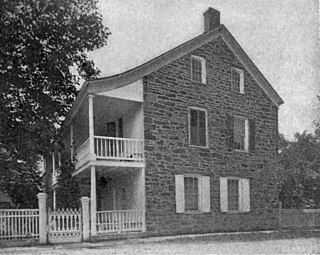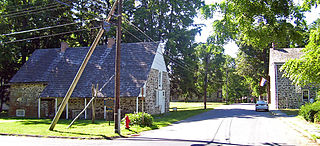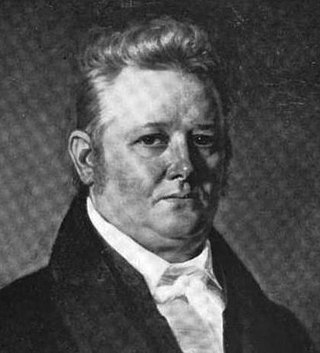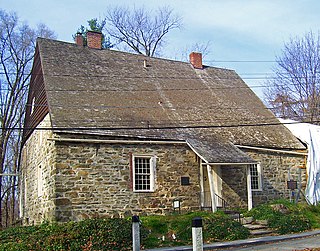
Rosendale is a hamlet located in the Town of Rosendale in Ulster County, New York, United States. The population was 1,285 at the 2020 census. It was also a census-designated place known as Rosendale Village until 2010, when the U.S. Census Bureau designated it Rosendale Hamlet. Some maps continue to list the place as just Rosendale. As of 2020, the "Hamlet" in the CDP name was dropped.

Louis Du Bois was a Huguenot colonist in New Netherland who, with two of his sons and nine other refugees, founded the town of New Paltz, New York. These Protestant refugees fled Catholic persecution in France, emigrating to the Rhenish Palatinate and then to New Netherland, where they settled in Wiltwyck and Nieuw Dorp (present-day Hurley, New York, settlements midway between New Amsterdam and Beverwyck before ultimately founding New Paltz.

Josiah Hasbrouck was a United States representative from New York. Born in New Paltz, he completed preparatory studies and conducted a general merchandising business. He was a second lieutenant in the Third Regiment of Ulster County Militia in 1780, and was supervisor of New Paltz from 1784 to 1786 and in 1793, 1794, and 1799 to 1805. He was a member of the New York State Assembly in 1796, 1797, 1802, and 1806.

Historic Huguenot Street is located in New Paltz, New York, approximately 90 miles (140 km) north of New York City. The seven stone houses and several accompanying structures in the 10-acre National Landmark Historic District were likely built in the early 18th century by Huguenot settlers fleeing discrimination and religious persecution in France and what's now southern Belgium. After negotiating with the Esopus Indians, this small group of Huguenots settled on a flat rise on the banks of the Wallkill River in 1678. The settlers named the site in honor of Die Pfalz, the region of present-day Germany that had provided them temporary refuge before they came to America. Archaeological finds indicate that the immediate area settled by the Huguenots was occupied by Native Americans prior to European contact. The site is one of the oldest continuously inhabited settlements in the United States.

Abraham Joseph Hasbrouck was a United States representative from New York and a slaveholder.

The Daniel Waring House, also known as Indian Hill, is located on River Road just outside the village of Montgomery, New York, United States. It sits on a large parcel of land overlooking the Wallkill River at the junction of River Road and NY 17K, just opposite the western approach to Ward's Bridge.

The New Hurley Reformed Church, listed on the National Register of Historic Places (NRHP) as the Reformed Dutch Church of New Hurley, is located on New York State Route 208 roughly 3 miles (4.8 km) north of the hamlet of Wallkill, New York, United States, midway between it and Gardiner to the north, in the town of Plattekill. It is a wooden structure built in the Greek Revival style during the 1830s. In 1982 it was listed on the NRHP.

The Jean Hasbrouck House is a historic house on Historic Huguenot Street in New Paltz, New York. Built in 1721, it is one of the best examples of colonial Dutch architecture in stone in the United States. The house is a National Historic Landmark and is part of the larger Huguenot Street Historic District, also a National Historic Landmark.

The Wallkill Valley Rail Trail is a 23.7-mile (38.1 km) rail trail and linear park that runs along the former Wallkill Valley Railroad rail corridor in Ulster County, New York, United States. It stretches from Gardiner through New Paltz, Rosendale and Ulster to the Kingston city line, just south of a demolished, concrete Conrail railroad bridge that was located on a team-track siding several blocks south of the also-demolished Kingston New York Central Railroad passenger station. The trail is separated from the Walden–Wallkill Rail Trail by two state prisons in Shawangunk, though there have been plans to bypass these facilities and to connect the Wallkill Valley Rail Trail with other regional rail-trails. The northern section of the trail forms part of the Empire State Trail.

The Andries DuBois House is located on Wallkill Avenue in the hamlet of Wallkill, New York, USA. It is one of the oldest houses in the hamlet, reflecting several different eras of architecture and regional history, and has been a Registered Historic Place since 1998.

Locust Lawn is a surviving 19th-century farm complex situated on the bank of the Plattekill Creek on New York State Route 32, outside of New Paltz, Ulster County, New York.

William Cornelius Hasbrouck was an American lawyer and politician.

The Locusts, also known as the Peter Eltinge House, is a 19th-century brick Federal style house built in 1826 located on Plains Road in the Town of New Paltz, New York, United States, two miles (3 km) south of the village of New Paltz. It was once the center of a large farm. The house and several outbuildings have been listed on the National Register of Historic Places as well-preserved examples of that style in Ulster County.

The Lispenard–Rodman–Davenport House is a historic residence dating back to the early 18th century located on the Davenport Neck peninsula in New Rochelle, New York. The house is the oldest residential structure in New Rochelle. It was listed on the National Register of Historic Places in 1986.

New Paltz is a village in Ulster County located in the U.S. state of New York. It is approximately 80 miles (130 km) north of New York City and 70 miles (110 km) south of Albany. The population was 7,324 at the 2020 census.

New Paltz is an incorporated U.S. town in Ulster County, New York. The population was 14,407 at the 2020 census. The town is located in the southeastern part of the county and is south of Kingston. New Paltz contains a village, also with the name New Paltz. The town is named for Palz, the dialect name of the Palatinate, called Pfalz in standard German.

The Hendrick Martin House is located on Willowbrook Lane in the town of Red Hook, New York, United States, just north of the eponymous village. It is a stone house built in two phases in the mid- and late 18th century. In 2007 it was listed on the National Register of Historic Places.

New Paltz station is a former train station in the village of New Paltz in Ulster County, New York. The building was the first of two railroad stations constructed in the town of New Paltz, and it is the only former Wallkill Valley Railroad station standing at its original location.

The Stow-Hasbrouck House is a single-family home located at 18600 16 Mile Rd, in Convis Township, Michigan, near Marshall. It was listed on the National Register of Historic Places in 1993.
The Hasbrouck family was an early immigrant family to Ulster County, New York, and helped found New Paltz, New York. The Hasbrouck family were French Huguenots who fled persecution in France by moving to Germany, and then the United States. Two brothers, Jean II and Abraham, are the ancestors of almost all individuals in the United States with the last name "Hasbrouck," or some variation.




















